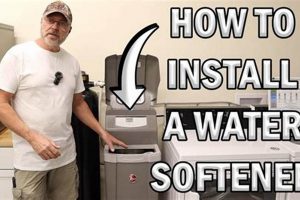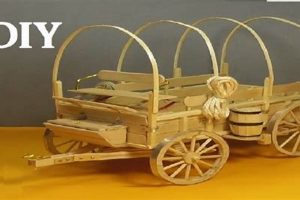The practice of performing comprehensive cleaning, restoration, and protection procedures on a motor vehicle using readily available products and tools, typically by the vehicle’s owner, represents a significant area of automotive care. This encompasses tasks ranging from washing and waxing the exterior to deep cleaning the interior components and applying protective coatings.
This approach to vehicle maintenance offers considerable advantages, including cost savings compared to professional services and a greater sense of control over the products and techniques employed. Historically, maintaining a vehicle’s appearance was primarily the domain of professional auto detailers. However, with increasing accessibility of information and specialized products, more individuals are embracing this as a rewarding and economical alternative.
The following sections will delve into specific aspects of this activity, covering essential tools, product selection criteria, and step-by-step guides for various procedures involved in maintaining the aesthetic appeal and value of a vehicle.
Essential Techniques for Automotive Aesthetic Maintenance
The subsequent guidelines offer valuable insight into effective strategies for enhancing and preserving a vehicle’s visual appeal through owner-performed detailing processes. Proper execution of these techniques contributes to the longevity and value of the automobile.
Tip 1: Commence with a thorough pre-wash rinse. Removing loose debris before any contact wash minimizes the risk of scratching the paint surface. Employ a pressure washer or a strong stream of water for optimal results.
Tip 2: Implement the two-bucket wash method. Utilize one bucket for soapy water and a separate bucket with clean water for rinsing the wash mitt. This prevents reintroducing contaminants back onto the vehicle’s surface.
Tip 3: Select pH-balanced cleaning solutions. Aggressive chemicals can damage the paint, trim, and protective coatings. Opt for products specifically formulated for automotive applications.
Tip 4: Utilize microfiber towels for drying and polishing. These towels are designed to be gentle on painted surfaces and effectively lift dirt and residue. Designate separate towels for different tasks to prevent cross-contamination.
Tip 5: Apply wax or sealant in thin, even layers. Overapplication of these products can lead to a hazy or streaky finish. Follow the manufacturer’s instructions for optimal application and removal techniques.
Tip 6: Address interior surfaces systematically. Begin with vacuuming, followed by cleaning upholstery and trim. Protect interior surfaces with UV protectants to prevent fading and cracking.
Tip 7: Clean and protect leather surfaces with specialized products. Leather requires specific care to maintain its suppleness and prevent cracking. Use dedicated leather cleaners and conditioners.
Consistent adherence to these principles promotes a well-maintained and visually appealing vehicle. These practices contribute to a higher resale value and overall owner satisfaction.
The ensuing section will explore advanced techniques and specialized treatments for further enhancing the results of these procedures.
1. Preparation
Adequate preparation forms the foundational element of effective vehicle aesthetic maintenance. The quality of the final result is directly correlated with the thoroughness of the preparation phase. Neglecting this stage can lead to compromised outcomes and potential damage to the vehicle’s surfaces. For example, failure to adequately rinse loose contaminants from the vehicle’s exterior prior to washing introduces abrasive particles that can cause swirl marks and scratches in the paint finish. Similarly, neglecting to mask off sensitive areas, such as rubber trim or plastic components, can result in staining or damage from cleaning agents or polishing compounds.
Preparation extends beyond the physical cleaning of the vehicle’s surfaces. It also encompasses the gathering and organization of necessary tools and materials. Having all required items readily accessible minimizes interruptions and streamlines the detailing process. Furthermore, proper preparation includes inspecting the vehicle’s condition to identify areas requiring specific attention, such as heavily soiled areas, water spots, or oxidation. This assessment allows for the selection of appropriate products and techniques to address these specific issues effectively. Failing to identify and address these problems early can result in unsatisfactory results or even exacerbate existing damage.
In summation, meticulous preparation is an indispensable component of achieving professional-quality results. It minimizes the risk of damage, optimizes the effectiveness of subsequent detailing steps, and ensures a more efficient and enjoyable experience. Investment in thorough preparation yields significant dividends in the form of a superior aesthetic outcome and the preservation of the vehicle’s condition. Ignoring preparation is an invitation to suboptimal outcomes and potentially costly repairs.
2. Cleaning Agents
The selection and application of appropriate cleaning agents are critical determinants in the efficacy and safety of vehicle aesthetic maintenance. The direct correlation between cleaning agent properties and the integrity of the vehicle’s various surfaces necessitates a thorough understanding of their chemical compositions and intended applications. Incorrect selection can lead to irreversible damage, including paint etching, discoloration, and degradation of protective coatings. For instance, the use of alkaline-based cleaners on anodized aluminum trim can result in corrosion and permanent staining. Similarly, solvents not specifically formulated for automotive interiors may damage or discolor plastic and vinyl components.
The diversity of materials found on vehicles necessitates a varied arsenal of specialized cleaning agents. These include, but are not limited to, pH-balanced soaps for painted surfaces, degreasers for engine bays and wheels, interior cleaners for upholstery and dashboards, and glass cleaners for windows and mirrors. Each category serves a distinct purpose and is formulated to address specific types of contaminants without compromising the underlying surfaces. The practical significance of this understanding is evident in the longevity and appearance of the vehicle. Proper selection and use of cleaning agents can significantly extend the lifespan of paint, trim, and interior materials, thereby preserving the vehicle’s resale value and aesthetic appeal.
In summary, the judicious selection and proper application of cleaning agents constitute a fundamental aspect of responsible vehicle maintenance. The ramifications of improper selection can range from minor cosmetic blemishes to severe and costly repairs. Therefore, diligent research, careful consideration of
material compatibility, and adherence to manufacturer guidelines are essential to ensure the safe and effective cleaning and preservation of the vehicle’s surfaces.
3. Application Techniques
The effectiveness of vehicle aesthetic maintenance is inextricably linked to the application techniques employed during the detailing process. Even the highest-quality cleaning agents and protectants will yield suboptimal results if not applied correctly. Precise and deliberate application is therefore essential for achieving the desired aesthetic outcome and preserving the integrity of the vehicle’s surfaces.
- Surface Preparation Before Product Application
Prior to applying any cleaning or protective product, proper surface preparation is paramount. This includes a thorough cleaning to remove all dirt, grime, and contaminants. The method of application, whether it be using a microfiber cloth, applicator pad, or sprayer, must be appropriate for both the product and the surface being treated. Inadequate preparation can result in uneven product distribution, reduced effectiveness, and potential surface damage. For instance, applying wax to a dirty surface can trap contaminants, leading to scratches and swirl marks during the buffing process.
- Consistent and Even Product Distribution
Achieving a uniform layer of product is crucial for achieving consistent results. Over-application of certain products, such as waxes and sealants, can lead to streaking and hazing, requiring additional effort to correct. Conversely, under-application can result in inadequate protection and a lackluster finish. Employing precise application techniques, such as overlapping strokes or a circular motion, ensures comprehensive coverage and minimizes the risk of uneven distribution. Furthermore, the use of appropriate applicators, such as foam pads for waxes and sprayers for coatings, promotes even distribution and optimizes product performance.
- Appropriate Pressure and Motion During Application
The amount of pressure and the type of motion used during product application significantly impact the final result. Excessive pressure can damage delicate surfaces, while insufficient pressure may result in ineffective cleaning or protection. The appropriate application technique will vary depending on the product and the surface being treated. For example, polishing requires controlled pressure and consistent motion to remove imperfections and restore shine. Similarly, applying coatings requires a light touch and precise movements to ensure uniform coverage and prevent streaks or blemishes. Careful attention to pressure and motion is therefore essential for achieving optimal results without causing damage.
- Following Manufacturer’s Instructions
Adhering to the manufacturer’s guidelines for each product’s application is critical. These instructions provide specific recommendations for surface preparation, application techniques, and product removal, all of which are tailored to the product’s unique properties. Deviating from these instructions can compromise the product’s performance and potentially damage the vehicle’s surfaces. For example, some products require specific curing times or temperature ranges for optimal bonding. Failure to adhere to these requirements can lead to premature failure or a substandard finish. Consistently following manufacturer’s instructions ensures that each product is applied correctly and that the vehicle receives the intended level of protection and enhancement.
These techniques are intertwined with the success of vehicle aesthetic maintenance. Thorough surface preparation enhances the efficacy of subsequent steps. Consistent product distribution guarantees uniform protection and an even finish. Appropriate pressure and motion during application prevent damage and optimize results. Furthermore, adherence to manufacturers instructions ensures product compatibility and longevity. Correct application techniques are not merely procedural steps; they represent a vital element in the effective preservation and enhancement of the vehicle’s appearance.
4. Surface Protection
Effective vehicle aesthetic maintenance necessitates proactive surface protection as a critical component. The practice of shielding exterior and interior materials from environmental degradation and physical damage directly influences the vehicle’s long-term appearance and value. Without adequate safeguards, automotive surfaces are vulnerable to a multitude of adverse factors, including ultraviolet radiation, acid rain, industrial fallout, road salts, and abrasion from cleaning processes. Surface protection, therefore, serves as a preventive measure to mitigate these risks and maintain the vehicle’s aesthetic integrity. Examples of inadequate protection include the fading and cracking of dashboards exposed to prolonged sunlight, the etching of paintwork by acid rain, and the corrosion of metal components exposed to road salts. These instances underscore the importance of employing effective surface protection strategies.
The practical application of surface protection encompasses various techniques and materials tailored to specific vehicle components. For painted surfaces, the application of waxes, sealants, or ceramic coatings provides a barrier against environmental contaminants and UV radiation, while also enhancing gloss and water repellency. Interior surfaces, such as upholstery and dashboards, benefit from the application of protectants that shield against fading, cracking, and staining. Leather surfaces require specialized conditioners to maintain their suppleness and prevent drying and cracking. Furthermore, the use of protective films on vulnerable areas, such as headlight lenses and door edges, provides an additional layer of defense against abrasion and impact damage. The selection of appropriate surface protection products is contingent upon factors such as the vehicle’s environment, usage patterns, and the owner’s aesthetic preferences. This choice has a direct influence on longevity, effectiveness and overall cost.
In conclusion, surface protection is an indispensable aspect of vehicle aesthetic maintenance, acting as a shield against degradation and preserving the vehicle’s appearance and value. The challenge lies in selecting and applying appropriate protection measures tailored to the specific needs of each vehicle. However, with informed decision-making and diligent application, surface protection offers a cost-effective means of extending the lifespan of automotive finishes and materials, thereby contributing to long-term owner satisfaction and the preservation of the vehicle’s investment.
5. Equipment Maintenance
Effective vehicle aesthetic maintenance is contingent upon the consistent functionality of the tools employed. Equipment maintenance, therefore, constitutes an indispensable component. The failure to properly maintain detailing equipment can result in suboptimal performance, increased risk of surface damage to the vehicle, and a reduction in the equipment’s lifespan. For example, neglecting to clean polishing pads after use can lead to the accumulation of abrasive residue, subsequentl
y causing swirl marks during the next detailing session. Similarly, failure to maintain proper air pressure in a pressure washer can compromise its cleaning efficiency and potentially damage delicate vehicle components.
The practical implications of equipment maintenance are multifaceted. Regular cleaning and inspection of detailing brushes prevent the build-up of dirt and debris that can scratch paint surfaces. Proper lubrication of mechanical components, such as buffers and polishers, ensures smooth operation and extends their operational lifespan. Calibration and maintenance of pressure washers guarantee consistent water pressure and prevent damage to delicate surfaces. Furthermore, the correct storage of detailing chemicals and products prevents contamination and degradation, thus preserving their effectiveness. A consistent maintenance schedule, adhered to rigorously, is essential for preserving the integrity and performance of detailing equipment.
In summary, meticulous equipment maintenance is crucial for achieving professional-quality results and ensuring the longevity of detailing equipment. The lack of proper maintenance can lead to increased risks of surface damage, reduced cleaning efficiency, and premature equipment failure. Therefore, integrating regular cleaning, inspection, and lubrication into the detailing process represents a sound investment in both the vehicle’s appearance and the longevity of detailing tools.
6. Environmental Conditions
Environmental conditions exert a considerable influence on the efficacy and outcome of vehicle aesthetic maintenance. These factors directly impact product performance, drying times, and the overall quality of the detailing process. Neglecting to account for ambient temperature, humidity, and sunlight exposure can lead to compromised results and potential damage to the vehicle’s surfaces. For instance, detailing a vehicle in direct sunlight can cause cleaning agents to dry prematurely, leaving behind streaks and water spots. Similarly, high humidity levels can impede the curing process of waxes and sealants, reducing their protective capabilities. The interplay between environmental factors and detailing procedures is a critical consideration for achieving optimal results.
The practical implications of understanding these environmental influences are significant. Detailing during cooler, overcast days minimizes the risk of rapid product evaporation, allowing for more thorough cleaning and application. Performing interior detailing in a well-ventilated area reduces the concentration of volatile organic compounds (VOCs) released by cleaning products, improving air quality and minimizing potential health risks. Furthermore, selecting products specifically formulated for use in certain climates can enhance their performance and longevity. For example, using waxes with high melting points in warmer climates prevents them from softening and attracting dirt, while using de-icing agents during winter months helps to prevent the build-up of ice and snow on vehicle surfaces.
In summary, environmental conditions represent a crucial variable in vehicle aesthetic maintenance. Recognizing the impact of temperature, humidity, and sunlight exposure on product performance and surface integrity allows for more informed detailing practices. Adapting techniques and product selection to suit the prevailing environmental conditions is essential for achieving optimal results and protecting the vehicle from environmental degradation. The success of any detailing project hinges on a thoughtful consideration of the surrounding environment.
Frequently Asked Questions
The following addresses common inquiries regarding procedures performed without professional assistance on motor vehicles. This aims to clarify concerns and correct misconceptions.
Question 1: What are the core components of a comprehensive procedure?
A comprehensive vehicle aesthetic maintenance routine typically encompasses exterior washing and drying, paint correction (if necessary), application of protective coatings (wax, sealant, or ceramic coating), interior cleaning and detailing, and wheel and tire treatment. The scope may vary depending on the vehicle’s condition and the desired level of detail.
Question 2: What are the potential risks associated with performing these procedures without professional assistance?
Potential risks include paint damage from improper washing or polishing techniques, interior staining from incorrect cleaner application, and damage to sensitive components due to the use of inappropriate products or tools. Careful research and adherence to established best practices are essential to mitigate these risks.
Question 3: What specific tools and products are essential for achieving satisfactory results?
Essential tools include microfiber wash mitts and drying towels, a two-bucket washing system, a pressure washer (optional but recommended), a variety of detailing brushes, a vacuum cleaner, and appropriate applicators for waxes, sealants, and interior protectants. Essential products include pH-balanced car wash soap, wheel cleaner, tire dressing, interior cleaner, glass cleaner, and a protectant for paint, trim, and interior surfaces.
Question 4: How frequently should these procedures be performed to maintain the vehicle’s aesthetic appeal?
The frequency of these procedures depends on factors such as climate, driving conditions, and personal preferences. However, a basic wash should be performed every 1-2 weeks to remove dirt and grime. A more thorough detail, including paint protection and interior cleaning, should be performed every 3-6 months. Regular maintenance prevents the build-up of contaminants and preserves the vehicle’s finish.
Question 5: Can damage to the vehicle’s paint or interior be rectified through these procedures?
Minor paint imperfections, such as swirl marks and light scratches, can often be corrected through polishing. Interior staining may be removable depending on the type of stain and the material affected. However, severe damage, such as deep scratches or significant tears, may require professional repair.
Question 6: What are the long-term benefits of consistently performing vehicle aesthetic maintenance?
Consistent maintenance preserves the vehicle’s appearance, protects its surfaces from environmental damage, and helps to maintain its resale value. Moreover, regular detailing provides an opportunity to identify and address potential problems early, preventing more costly repairs in the future.
Diligent adherence to proper techniques, informed product selection, and a consistent maintenance schedule are crucial for successful vehicle upkeep. Understanding these components promotes longevity and aesthetic appeal.
The subsequent discourse will address advanced treatments for further refinement of these processes.
Conclusion
This exploration of vehicle aesthetic maintenance performed without professional assistance has underscored its multifaceted nature. The information presented emphasizes the importance of preparation, appropriate product selection, correct application techniques, surface protection, equipment maintenance, and consideration of environmental conditions. Mastery of these elements directly influences the quality and longevity of the results.
Consistent application of these principles not only enhances the vehicle’s appearance but also preserves its value and protects it from environmental degradation. A commitment
to diligence and informed practice represents a prudent investment in the vehicle’s long-term condition. Continued research and adaptation to evolving best practices will further refine the outcomes of these procedures.







